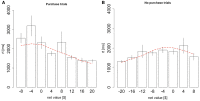The attentional drift-diffusion model extends to simple purchasing decisions
- PMID: 22707945
- PMCID: PMC3374478
- DOI: 10.3389/fpsyg.2012.00193
The attentional drift-diffusion model extends to simple purchasing decisions
Abstract
How do we make simple purchasing decisions (e.g., whether or not to buy a product at a given price)? Previous work has shown that the attentional drift-diffusion model (aDDM) can provide accurate quantitative descriptions of the psychometric data for binary and trinary value-based choices, and of how the choice process is guided by visual attention. Here we extend the aDDM to the case of purchasing decisions, and test it using an eye-tracking experiment. We find that the model also provides a reasonably accurate quantitative description of the relationship between choice, reaction time, and visual fixations using parameters that are very similar to those that best fit the previous data. The only critical difference is that the choice biases induced by the fixations are about half as big in purchasing decisions as in binary choices. This suggests that a similar computational process is used to make binary choices, trinary choices, and simple purchasing decisions.
Keywords: choice; decision neuroscience; decision-making; drift-diffusion; eye-tracking; neuroeonomics; purchasing; valuation.
Figures













Similar articles
-
Multialternative drift-diffusion model predicts the relationship between visual fixations and choice in value-based decisions.Proc Natl Acad Sci U S A. 2011 Aug 16;108(33):13852-7. doi: 10.1073/pnas.1101328108. Epub 2011 Aug 1. Proc Natl Acad Sci U S A. 2011. PMID: 21808009 Free PMC article.
-
The Attentional Drift Diffusion Model of Simple Perceptual Decision-Making.Front Neurosci. 2017 Aug 24;11:468. doi: 10.3389/fnins.2017.00468. eCollection 2017. Front Neurosci. 2017. PMID: 28894413 Free PMC article.
-
An attentional drift diffusion model over binary-attribute choice.Cognition. 2017 Nov;168:34-45. doi: 10.1016/j.cognition.2017.06.007. Epub 2017 Jun 21. Cognition. 2017. PMID: 28646751
-
Peripheral Visual Information Halves Attentional Choice Biases.Psychol Sci. 2023 Sep;34(9):984-998. doi: 10.1177/09567976231184878. Epub 2023 Jul 20. Psychol Sci. 2023. PMID: 37470671
-
A dynamic computational model of gaze and choice in multi-attribute decisions.Psychol Rev. 2023 Jan;130(1):52-70. doi: 10.1037/rev0000350. Epub 2022 Jan 13. Psychol Rev. 2023. PMID: 35025570
Cited by
-
Information processing biases in the brain: Implications for decision-making and self-governance.Neuroethics. 2018 Oct;11(3):259-271. doi: 10.1007/s12152-016-9251-1. Epub 2016 Mar 3. Neuroethics. 2018. PMID: 30555600 Free PMC article.
-
Facilitating animacy perception by manipulating stimuli exposure time.Front Psychol. 2023 Jan 12;13:1017685. doi: 10.3389/fpsyg.2022.1017685. eCollection 2022. Front Psychol. 2023. PMID: 36710764 Free PMC article.
-
Surprise, value and control in anterior cingulate cortex during speeded decision-making.Nat Hum Behav. 2020 Apr;4(4):412-422. doi: 10.1038/s41562-019-0801-5. Epub 2020 Jan 13. Nat Hum Behav. 2020. PMID: 31932692
-
Attention as foraging for information and value.Front Hum Neurosci. 2013 Nov 5;7:711. doi: 10.3389/fnhum.2013.00711. eCollection 2013. Front Hum Neurosci. 2013. PMID: 24204335 Free PMC article.
-
Decision making as a window on cognition.Neuron. 2013 Oct 30;80(3):791-806. doi: 10.1016/j.neuron.2013.10.047. Neuron. 2013. PMID: 24183028 Free PMC article. Review.
References
-
- Armel K. C., Beaumel A., Rangel A. (2008). Biasing simple choices by manipulating relative visual attention. Judgm. Decis. Mak. 3, 396–403
Grants and funding
LinkOut - more resources
Full Text Sources
Other Literature Sources

